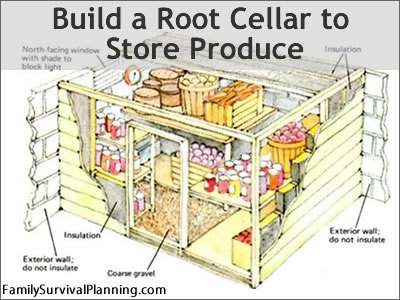How To Build An Earthbag Root Cellar | Storing a Year’s Worth of Food
Posted by admin on

The root cellar is made from earth bag construction. I got the poly bags as a mis-print cheap. The nice thing about this method is they breath proper humidity and don’t require a poured foundation.
Making a root cellar is really easy and I would highly recommend any one that wants to be more self sufficient build one. They are great and work really well. They do not take up much space so even if you have a small garden having one is still within reach.
In addition to raw produce, root cellars are excellent locations for a number of other foodstuffs as well. Storing beverages, like wine, cider and beer, all enjoy the cool, dark environment of a root cellar.
I have had a lot of messages over the years asking about pests getting in to root cellars. Yes. rats and mice are actually the ones that get in and can ruin your hard work by eating all of your food. This is easily fixed by installing wire mess on the ground and any gaps you might have. Most people miss this important part of building a root cellar.
Digging a Root Cellar
We are also a fossil-fuel-free urban homestead so digging our roughly 11-by 9-foot hole was done completely by hand. About half of the wonderful clay in the hole was used for our “One-Day Cob House” workshop in May and harvested by workshop participants during that weekend (we’re especially proud of that stacking of functions). The rest we dug piecemeal over several months. While I enjoy digging I never do it for more than an hour at a time unless we’ve created some sort of deadline. We also had an intern with us for a few months this past summer and she got to develop her digging skills in the root cellar quite regularly. In fact, she also dug most of our driveway Hugelkultur beds and several holes in our backyard for tree guilds. Lucky girl!
When we got to about 3 and a half feet deep I called it quits. I’m optimistic that will be deep enough to make good use of the constant coolness of the Earth. We went with earthbags for the walls until above grade and then used Balecob to the roof. Earthbags seemed the perfect fit for several reasons:
• I like working with them
• We had a ton of clay, stone, sand from our recently dug up driveway beds. Really an ideal mix for earthbags. We also added about 48 oz. of Portland cement to each bag to harden them up.
• They are inexpensive. I bought 200 of the 14-inch by 26-inch variety for about $80 and used them all.
• They partner nicely with cob and strawbales
I laid several inches of gravel on the bottom (including under the bags) and went round and round and up and up filling and tamping until reaching grade. In total we laid 9 rows of these bags. From there I added one more row of big bags (leftover feed bags from Feed World in Reno). These were heavy, but they got me about 8 inches above grade in most spots and are wide enough to hold a bale set on edge nicely. A bale is about 17 inches wide at its narrowest dimension (on edge) – the one I’ll be using above the bags. From what I recollect a strawbale set this way has an R-value of about 30. In addition to its insulative value, we chose to use bales because we want to cover their exteriors with luscious earthen plaster which we’ll get to put on and look at every day.
Other Root Cellar Features
I also set in “deadmen” of leftover redwood 4-inch by 4-inch scraps so I can attach shelving and tie in the roof beams with the shelves and walls. You’ll also notice some vent pipes (black 4-inch ABS pipe) that stand up outside the wall and enter between the earthbags towards the floor on the inside. These will be cut shorter above grade and serve to improve air flow in conjunction with a high 6-inch vent on the door side of the cellar. Two low and one high on opposite sides of the cellar will bring cool air down and flush warm air out and provide needed ventilation for our future crops. Root cellars need three components to function well: cool temps, high humidity, and good ventilation.
More to come as we finish and use our earthbag root cellar.
Books can be your best pre-collapse investment.
Carnivore’s Bible (is a wellknown meat processor providing custom meat processing services locally andacross the state of Montana and more. Whether your needs are for domestic meator wild game meat processing)
The Lost Book of Remedies PDF ( contains a series of medicinal andherbal recipes to make home made remedies from medicinal plants and herbs.Chromic diseases and maladies can be overcome by taking the remediesoutlined in this book. The writer claims that his grandfather was taughtherbalism and healing whilst in active service during world war twoand that he has treated many soldiers with his home made cures. )
Easy Cellar(Info about building and managing your root cellar, plus printable plans. The book on building and using root cellars – The Complete Root Cellar Book.)
The Lost Ways (Learn the long forgotten secrets that helped our forefathers survive famines,wars,economic crisis and anything else life threw at them)
LOST WAYS 2 ( Wordof the day: Prepare! And do it the old fashion way, like our fore-fathers did it and succeed longbefore us,because what lies ahead of us will require all the help we can get. Watch this video and learn the 3 skills that ensured our ancestors survival in hard times offamine and war.)
Survival MD (Best Post Collapse First Aid Survival Guide Ever)
Conquering the coming collapse (Financial advice and preparedness )
Liberty Generator (Build and make your own energy source)
Backyard Liberty (Easy and cheap DIY Aquaponic system to grow your organic and living food bank)
Bullet Proof Home (A Prepper’s Guide in Safeguarding a Home )
Family Self Defense (Best Self Defense Strategies For You And Your Family)
Survive Any Crisis (Best Items To Hoard For A Long Term Crisis)
Survive The End Days(Biggest Cover Up Of Our President)
Drought USA(Discover The Amazing Device That Turns Air Into Water)
The post How To Build An Earthbag Root Cellar | Storing a Year’s Worth of Food appeared first on PrepperFortress.


